Raising and training a German shepherd
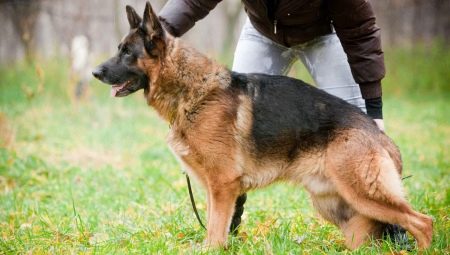
The German Shepherd is a very intelligent and quick-witted dog that makes a good companion and protector for the whole family. Competent upbringing and training will help to grow a reliable friend out of a pet, who will understand the owner perfectly and demonstrate all the capabilities of his breed.
The character and intelligence of the breed
In order for the dog to be trained correctly, you should know about the characteristics of the character of the chosen breed. Each animal has its own behavioral traits that affect training.
The German Shepherd belongs to the category of calm and balanced dog breeds that have high intelligence. The animal is characterized by such character traits as courage, the ability to independently make decisions and adapt to difficult situations.
The "Germans" have gained worldwide recognition as empathetic companions who gladly keep company with their owners. They are also loyal friends and get along well with all household members, treat children peacefully, and can act as a protector or guide dog.



This breed is easy to train, since the animal is strongly attached to people and happily performs all assigned tasks. Thanks to their intelligence, they are able to instantly understand what is required of them in a particular situation.
The German Shepherd is a unique dog that can achieve excellence in almost any field of training. Animals are often used in the following areas.
- Guard service. In the blood of the breed, there is distrust of strangers, therefore they successfully guard the objects entrusted to them.
- Search and rescue service. A good sense of smell allows dogs to find people in rubble and elsewhere.
- Shepherd's service. The "Germans" perform the role of a shepherd's assistant in a quality manner.
- Bodyguard. The Sheepdog is capable of protecting its owner and acts as an empathetic protector.
- Military service.
- Search for drugs and explosives. This breed is often used in government services.
- Border Service.
- Police.


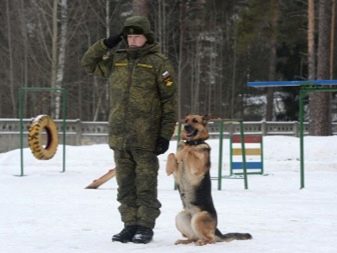

The versatility of dogs is conditioned by their flexible psyche along with demonstrative physical fitness... The German Shepherd Dog is distinguished by tirelessness, a high degree of endurance, it is not afraid of cold or rain, and it can also carry out assigned tasks for a long time. Thanks to all these factors, the breed is always present on any training ground, because no one is going to start such a dog for lying on the couch.
At what age can you start learning?
The German Shepherd should be trained from the first day, as soon as the puppy appears in the house. The young shepherd should start getting used to its name, location, basic commands and toilet location. Simple commands include "to me", "fu". Later, you can proceed with other basic commands along with the correct behavior in different situations.
More serious training should be done when the dog is 6 months old.
Experts recommend using help experienced instructorwho is engaged in group training or individual training.
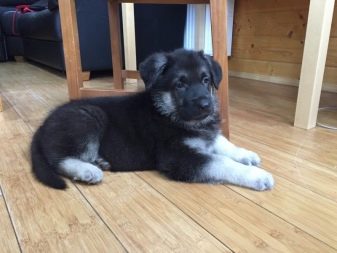
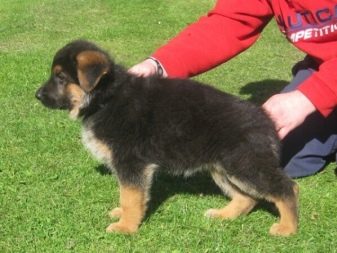
Fundamental rules
Before adopting a puppy, the owner must accept the fact that training for the dog is an integral part of the activity, which can be compared to going to kindergarten or school. Training is important not only for the dog, but also for humans, as an ill-bred dog can cause many problems.
Despite the fact that the German Shepherd is an intelligent dog by nature, it cannot by itself become obedient and well-mannered and will perform different actions due to the needs of the environment. The owner is obliged to teach his pet the key commands with which he can interact with his four-legged friend.
By training your pet correctly, the owner ensures safety not only for himself, but also for those around him.
Even while training on his own, the owner of the dog will be able to correct the dog's improper behavior, work on strengthening the developed abilities. During training, the teacher and his student learn to trust each other, understand and predict behavior. After some time, both sides will learn to understand each other on an almost telepathic level.
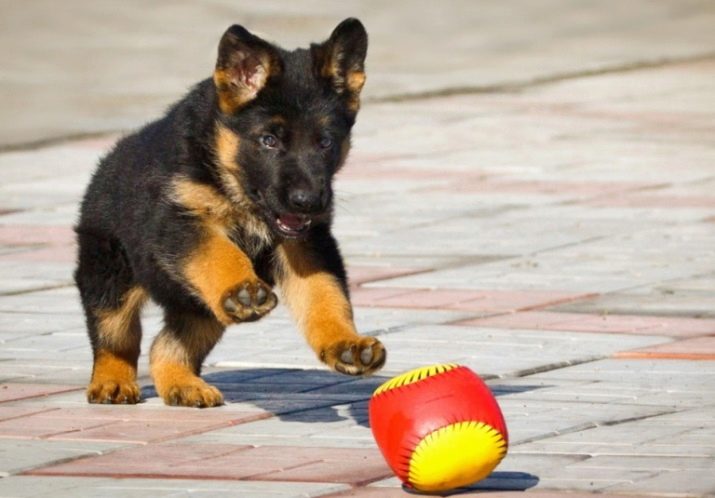
Some people mistakenly think that training is exhausting. This is not true if you approach the process correctly. With the right approach, "Germans" rejoice at new knowledge, because learning, a dog fulfills its mission - to be useful to humans. This is a blessing for the German Shepherd, which was bred to serve people.
If the owner has never encountered the training of service dog breeds, you will need to use the help of a professional dog handler who will teach you how to properly handle the animal. An experienced training instructor knows all the features of the breed, will explain the principle of training to a beginner and help you get a well-bred pet.
Before training, you should familiarize yourself with such a concept as reflexes, which are the animal's response to stimuli.
Understanding the principle of this term, you can understand the meaning of training. After all, all training is based on reflexes.
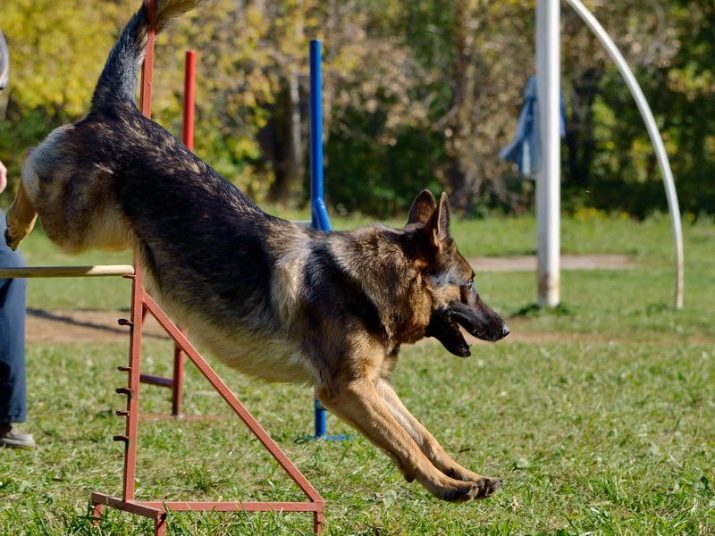
There are two types of reflexes: unconditional and conditional.
The first option is the innate reactions of the animal. Here you can place guarding, hunting instincts, food, sexual, defensive reactions. When teaching new skills, the trainer will use the food reflex, rewarding his student for a correctly completed task.
If the protective and defensive reflexes are well developed in the animal, this is also taken into account. Such representatives successfully manifest themselves in the protective guard service.
It is customary to call conditioned reflexes reactions that a dog has acquired throughout its life. In simple terms, this is the relationship that is created in the head of a dog while working with a person. When the owner rewards his pet for a correctly completed task, the reflex will look like this: completing the task - goodies - pleasure. In the opposite direction, reflexes also work. For wrong behavior, punishment overtakes, which causes discomfort in the animal.
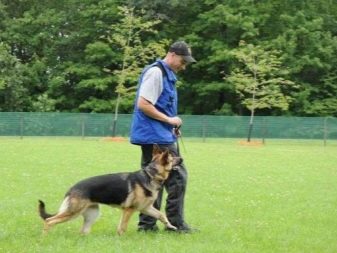
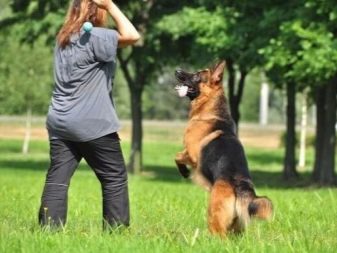
Any training, even the initial one, is built on the use of unconditioned reflexes to develop conditioned ones. Puppies that have innate feeding reflexes will try to get the treat out of their owner's hands by following directions. The trainer teaches the pet a certain skill, using food as motivation. By treating the dog, he develops conditioned reflexes in her.
Having settled a small puppy in your house, you need to remember that in the future the baby should become a well-bred dog. To achieve good results, there are three rules to keep in mind.
- Discipline. Many owners indulge their little friends and allow them more than they should. This should not be done, since every action must be tried on an adult dog. If a little puppy lies cute on the couch, then an adult dog will not delight and tender every person. What is not allowed for an adult dog should not be allowed for a small one.
- Encouragement... You need to treat the baby with care and guide him, praise him for the correct actions. You don't need to be strict. It is best to teach commands in the form of games. The animal feels everything like a child. Therefore, you need to praise your four-legged friend for going to the toilet in the right place, with success in the team, after eating.
- Schedule. Feeding should be done at the same time and from a bowl only. The dog must have its own place to eat. The mode will make life easier in the future, since you do not need to collect food leftovers throughout the house.
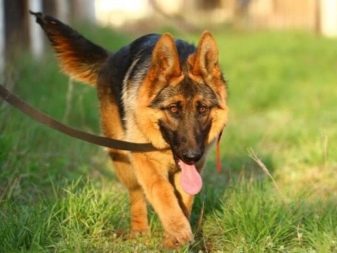
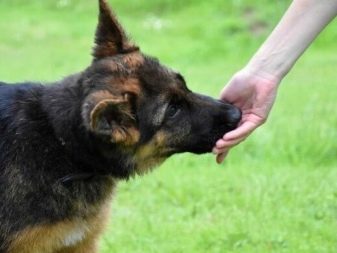
Raising puppies
Home training should be carried out from the first day after the puppy appears in the house. It is necessary to introduce classes gradually, as the German Shepherd matures.
1-2 months
The first command that a "German" puppy must learn is name training. When accustoming to a nickname, you need to remember that you cannot change it. In order for the animal to react to it, you must always call the dog the same.
You will also need training in a collar and leash, a muzzle. The kid should get acquainted with these accessories as soon as possible, so that in the future there will be fewer problems with such a question. When getting to know the collar, it is important not to scare the puppy. First, it is put on for a couple of minutes a day, after which the duration of the wear is increased. They teach them to leash and muzzle in a similar way, walking with the baby first in the apartment.
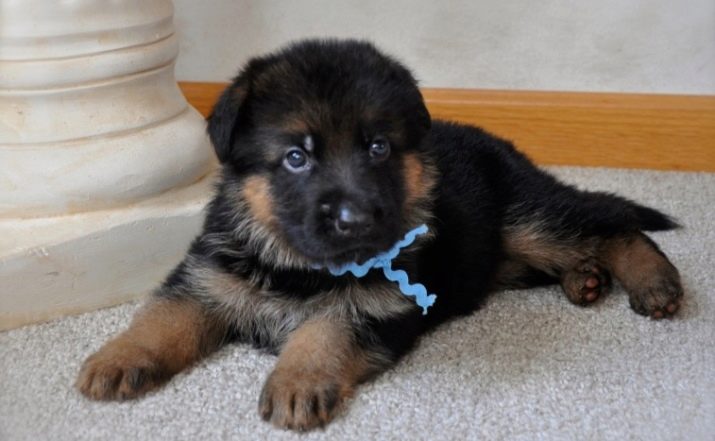
Since small dogs have not yet had time to be vaccinated, they should not be walked with.
For this reason, the baby's toilet will also be located in the house. It is necessary to teach a little friend to discipline immediately, taking him after feeding or drinking to the designated place. If the owner noticed that during the game the puppy began to behave anxiously and to sniff out something, this is also a sign that he is looking for a place for the toilet. After the successful completion of the affairs, the baby needs to be praised.
If the kitten has done his business in the wrong place, you can poke him a little and show him to the place where he was supposed to go to the toilet. An important rule: such manipulations can be carried out immediately after the accomplishment. After some time, the dog will no longer remember what it did and what it is being scolded for now.

3-4 months
During this period, you can teach the dog to the basic commands. Each owner should remember the following rules:
- you cannot scold a four-legged friend for not following commands;
- a good habit is patience, with its help you can achieve success and gain the trust of the animal.
You can study the following list of commands.
- "To me". When beckoning an animal, you need to use sweets. After the dog completes the task, it is treated. It is strictly forbidden to use this command in order to scold an animal. "To me" should only be used in a positive way. So the dog will willingly follow the instructions of its owner.
- "A place". To bring up a puppy, he must be accustomed to such a command, regardless of where the dog will live: in an apartment or in a private house. She must have her own place, where she will go on command unquestioningly. You can teach with the help of goodies. In place you need to put a treat and send the dog there. After a while, the baby himself will be sent to the right place. You need to say this command every time the owner leaves the home.
- "Ugh"... This is an important command and should be pronounced in a more severe voice. The animal must understand that the owner is unhappy with his behavior, so you can slap the puppy a little. You cannot hit the dog while uttering this command. Sheepdogs are very quick-witted, so they quickly understand what is required of them.

Practicing basic commands with a dog allows you to walk down the street without any problems in the future and master new commands in the presence of other stimuli (dogs, people).
5-6 months
In this age group, puppies, already considered adolescents, are taught skills that help develop endurance. Such teams can be honed at the age of 7-8 months and up to a year. As usual, a reward is applied.
You need to teach your pet the commands "near", "sit", "lie down", "stand". These sends are executed until the moment when the owner says "walk". Classes are held first for a few seconds, after which the duration of the workout increases.
You can also start blocking exercises. In this regard, you should observe the measure, since the skeleton of the dog is not yet fully developed and can be harmed.
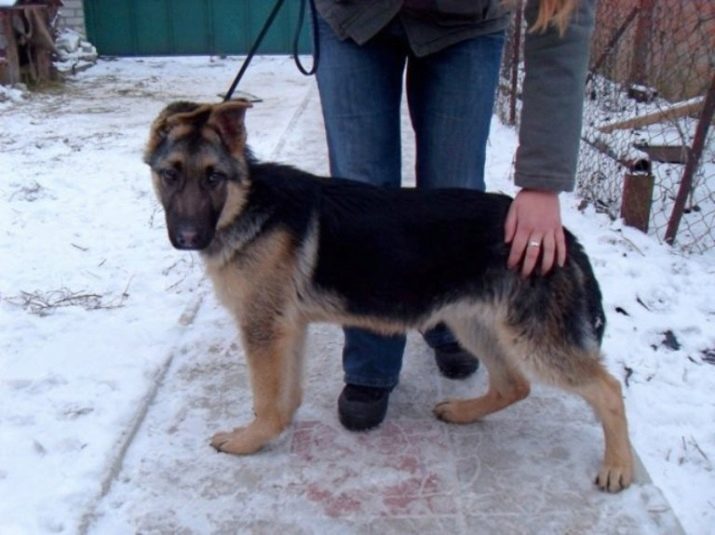
In a playful way, while walking, you can throw a stick and ask the dog to bring it. Since the "German" wants to please his master, he will gladly bring it. When executing the command, be sure to praise your pet.
Classes should be held every day.
Take time every day to train your pet. The start of training should not be postponed. Immediately you need to start raising a little friend so that he remembers and perceives everything more quickly.
Training for a dog is a regimen and a way of life. If you do not use this rhythm right away, the animal will get used to another, and retraining an adult animal with established habits is much more difficult.
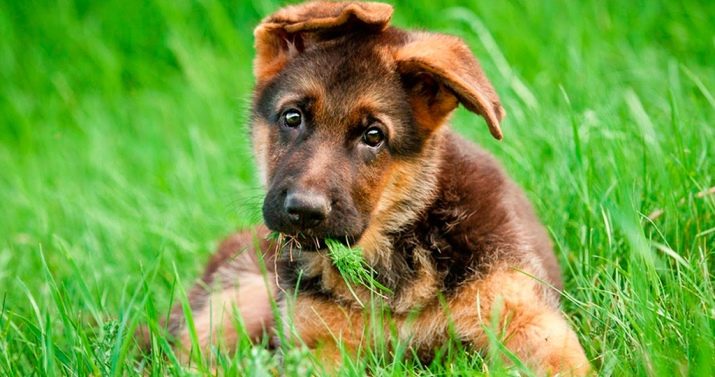
How long does it take to train a German puppy?
The training process lasts from 2-12 months. At this time, the dog requires utmost attention from its owner. The responsibility of the owner depends on how well-mannered the animal will be. The character of his dog depends on the endurance and calmness of the owner.
How to train an adult dog?
To train an adult dog is a little more difficult than a puppy, since the animal has already formed according to its habits and is more difficult to retrain.But the German Shepherd catches everything literally on the fly and with trust between the owner and the pet, the learning process will be easy.
It is important to exercise patience and calmness while training.
Each dog must complete the OKD course. This is a general training course, which includes a mandatory list of commands that allows the dog to be educated in society and to behave adequately under various stimuli.
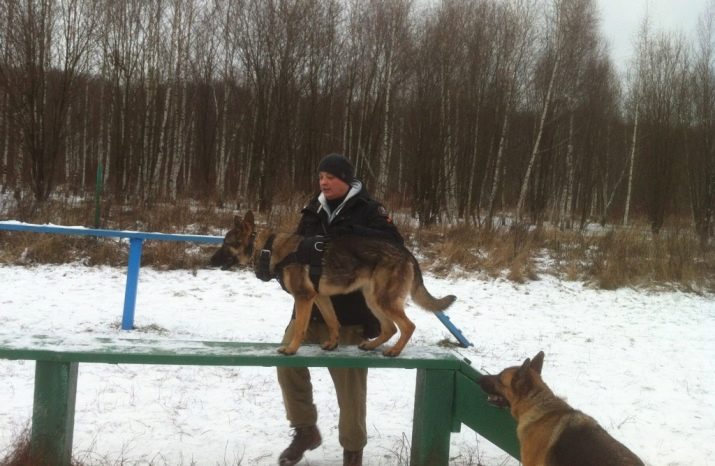
List of commands for the general course of training.
- "Nearby". The dog should move alongside its owner regardless of the environment. A deviation forward by half of the animal's body is allowed. Similar requirements are put forward when moving without a leash. When the owner stops, the dog should sit next to him. The movement of the animal is made on the left side of the person.
- Demonstration of bite and loyalty to the muzzle. The bite is required at exhibitions, as well as during visits to the veterinarian.
- "Sit", "Lie down", "Stand".
- "To me".
- "A place".
- "Aport"... This command is executed together with the "give" command.
- "Take a walk". When this instruction is given, the animal can freely move around the adjacent territory.
- Reaction to food scattered on the ground. The dog should not pick up food from the floor.
- Attitude towards gunshots and loud noises.
- "Ugh".
- Overcoming the obstacle. It is performed in conjunction with the command "forward" and "barrier", during which the animal jumps over the obstacle.

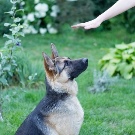

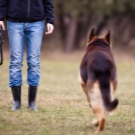

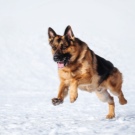
Each person decides for himself what commands his pet will need. However, it should always be remembered that the German Shepherd must be trained as it was bred as a service breed. Officially, the "Germans" are recognized as service dogs in Russia, Belarus, Ukraine and are potentially dangerous.
The appearance of destructive individuals in society is unacceptable, as it poses a danger to society.
How the training of teams of adults is carried out.
- "Sit". It is carried out with a little effort. You will need to gently press the dog on the croup, saying the command "sit". When the animal sits down, you can treat it to a treat. Some owners place the treat over the dog's head and tilt it back slightly. The dog will automatically sit down when trying to follow the food. At the same time, one must not forget to pronounce the command and be sure to praise the pet after execution.
- "Lie"... It is made using a similar technique, only you need to press on the shoulders of the animal. You can use a leash, which pulls the dog to the ground, beckoning with a treat.
- "Give your paw." Many consider this to be the simplest command that most owners use for fun. It is performed from a sitting position. Take a paw from the dog and say the command aloud. After this, the pet needs to be praised and treated with a treat. After several procedures, the animal will understand what is required of it, and will happily give a paw to a person on its own.
- You can also teach the "voice" command with a treat. The food is clamped in the hand so that the animal sees it, but cannot take it. You can press it with your finger and place your hand at shoulder or face level. The dog will not understand why it is teased with a treat and is not given and will give a voice. In this case, be sure to say the command out loud.
- "Aport". Training can begin at the moment when the pet is ready to play and brings the wand himself. You must first throw the toy a short distance, after which the pet should be called to you, calling it by name and pronouncing the command. Taking a toy from a "German", you need to praise him and repeat the process again.
- Weaning from picking up food from the ground is done primarily for safety reasons. An animal that eats food scattered on the street may be poisoned. Therefore, this command should be performed flawlessly. Pepper can be added to the food so that the dog understands that it can be dangerous.In this case, the word "drop" should be used.

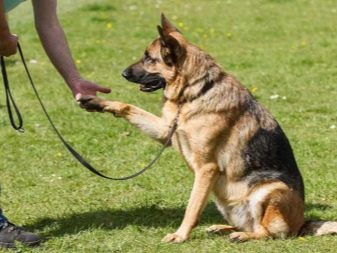
Service dogs must be trained in professional commands. Most shepherd dogs are bred for protection. To carry out the instructions, they say to the dog “guard”. After that, the animal should not allow anyone to approach the object entrusted to it.
The "trail" is used to find hidden objects. It is also used in service dog breeding.
"Take" or "face" is used to attack the attacker. The course is called ZKS (protective guard service) and should only be conducted by a professional dog handler. At the same time, the skills "fu", "release", "calmly" are being learned.
If a "German" is acquired as a guard of a dwelling or other object, it is imperative that an appeal to a dog handler is required, who will work out the basic commands, check the skills and abilities of the shepherd.

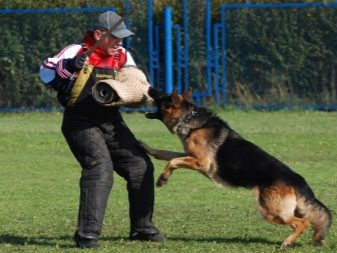
Types of teams
There are two kinds of commands: voice and gestures.
During voice commands, all orders should be given in a clear and clear voice. It is important to pronounce them with the same intonation and only once. If it is practiced "to me", you can repeatedly call the dog by name, but the order itself is given only once.
Dogs are unable to make out specific words, but can remember the number of syllables along with the intonation spoken. For this reason, dog breeders advise to speak commands with the same intonation and not distort their names.
Some people practice with their pets in German. This method is used during sports training of the international system, as well as to prevent a stranger from controlling the dog.
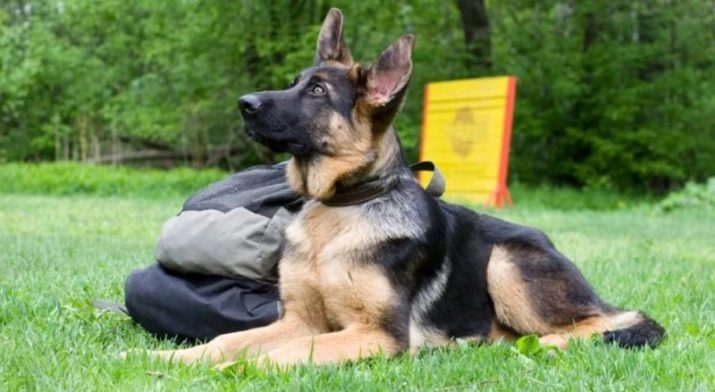
Giving orders with gestures means that the owner does not say the command aloud, but only shows a certain gesture. From the outside it looks quite impressive and carries with it usefulness. Over time, the shepherd will age and its hearing will no longer be the same. With the help of gestures, you can facilitate the process of understanding between the pet and its owner.
How gestures are made.
- "To me". The arm should be parallel to the ground. The palm should be facing down. When giving the order, the hand should be sharply lowered to the thigh. Cotton is not allowed.
- "Take a walk". With the palm down, you should throw your hand forward from yourself.
- "Sit". The arm bent at the elbow should be at chest level. At the same time, the palm is turned towards the animal.
- "Lie". The hand is at chest level with the palm facing the ground.
- "Stand"... The hand is at chest level, the palm is facing up.
All gestures should be done with the right hand.
Training by means of gestures can be started only after the shepherd has learned all the voice exercises.


Frequent mistakes
Every person who becomes the owner of a German Shepherd puppy dreams that his pet in the future will become an intelligent and exemplary dog. Everyone wants his animal to clearly follow the instructions and be distinguished by a high degree of discipline. Despite the fact that everyone dreams of this, not everyone spends enough time and energy on this.
Some owners feed their pet, go for walks with it, but neglect training. Disorderly domestic discipline also takes a toll on the dog's upbringing process. If a four-legged friend sleeps where he pleases and takes food in different places, he will not be able to behave decently on the street. To avoid such situations, you should familiarize yourself with common errors.
- Physical punishment. Severe penalties are not permitted.
- Conducting rare activities. Training should be done on a daily basis. Only with the help of a serious and responsible approach can the desired result be achieved.
- Lack of attention from the owner. To raise a loyal friend, you need to devote enough time to him, not to ignore your friend.This applies not only to babies, but also to adults.
- Lack of mental and physical activity... Only if the owner teaches his pet can he get a well-bred and cultured dog.
- Persistence in prohibitions... If the shepherd is not allowed to lie on the couch, this prohibition must be permanent. No exceptions allowed. If the owner cannot show stability, the animal can also run errands according to mood.

For information on where to start training a puppy, see the next video.






































